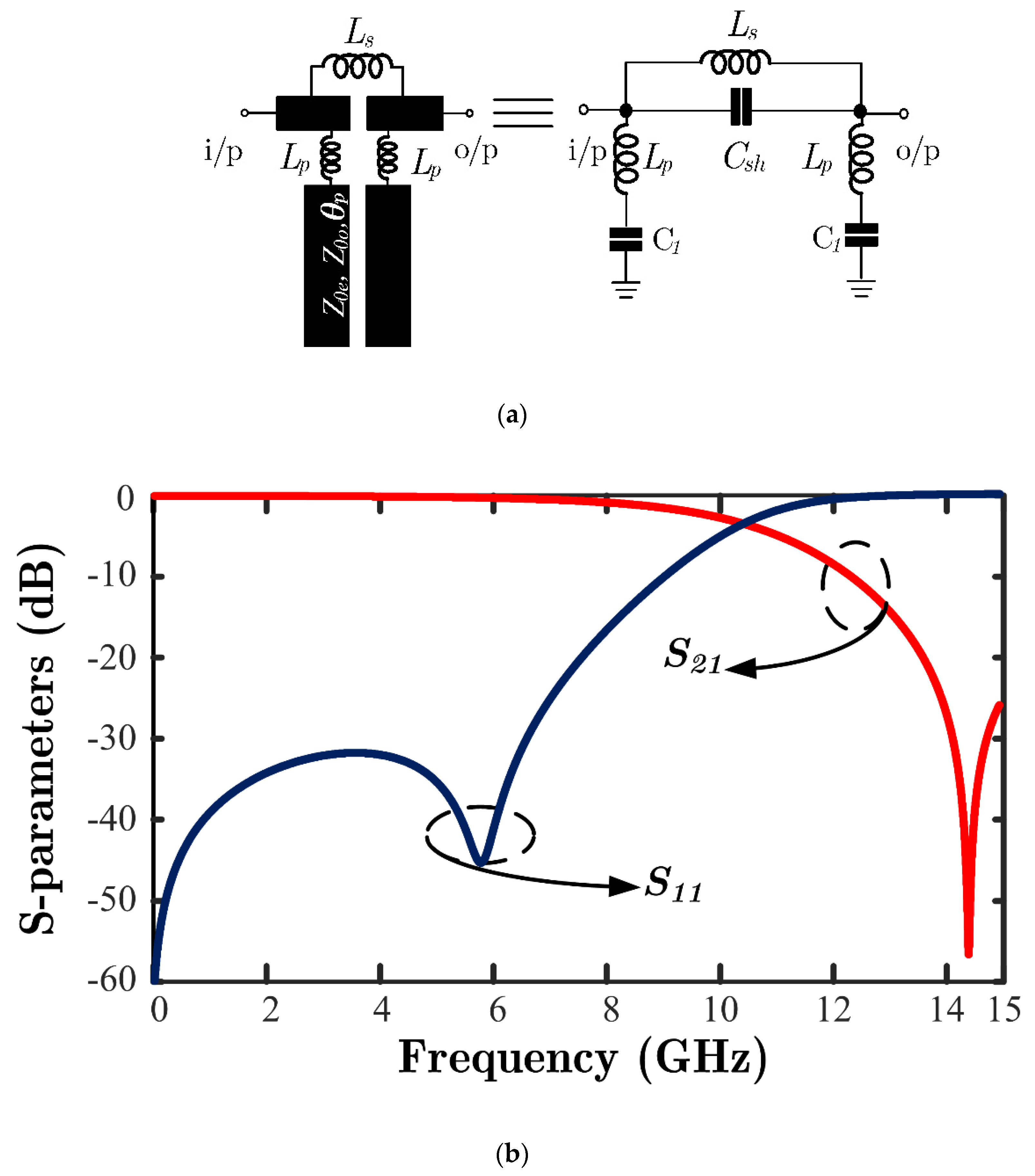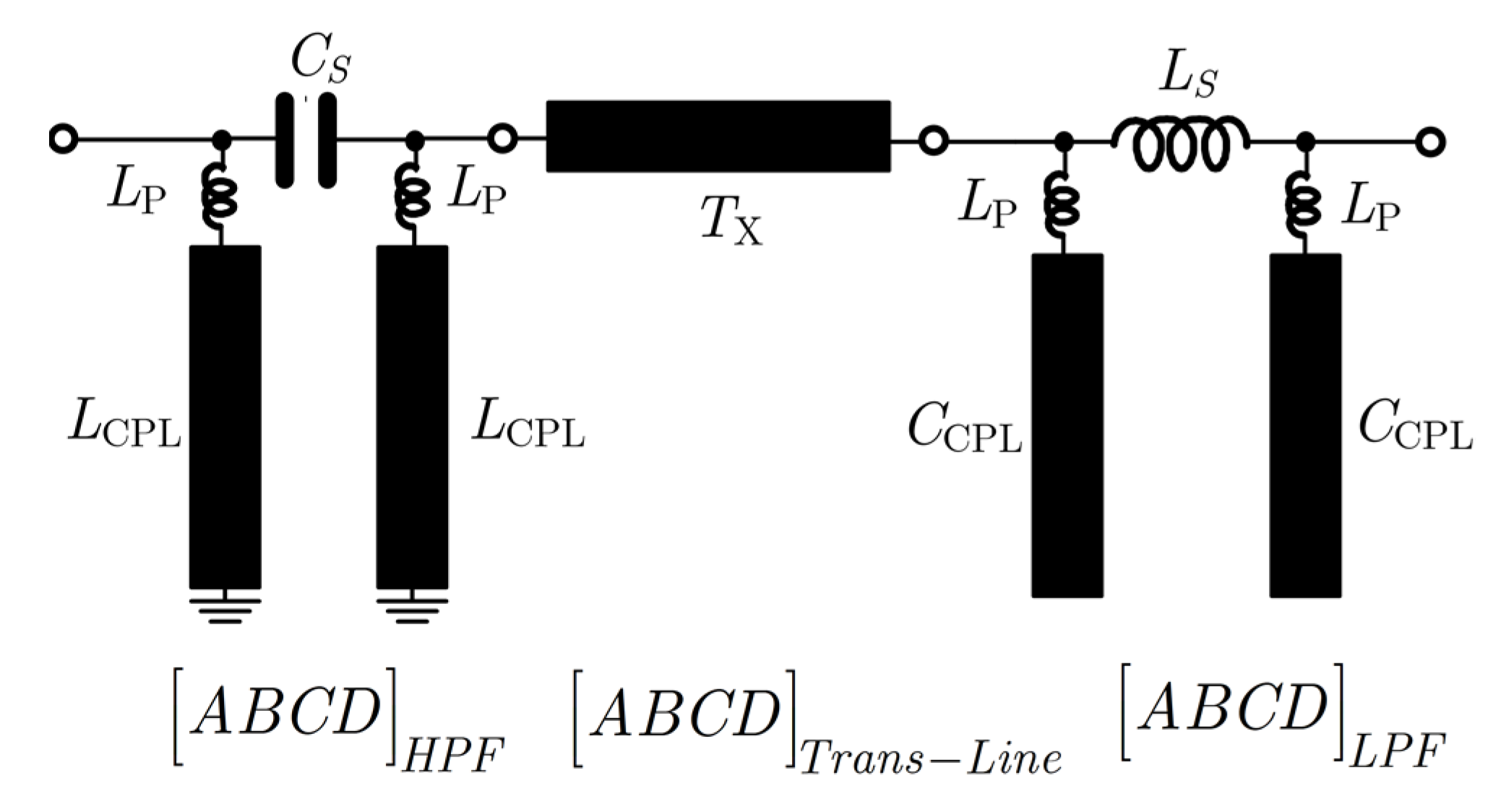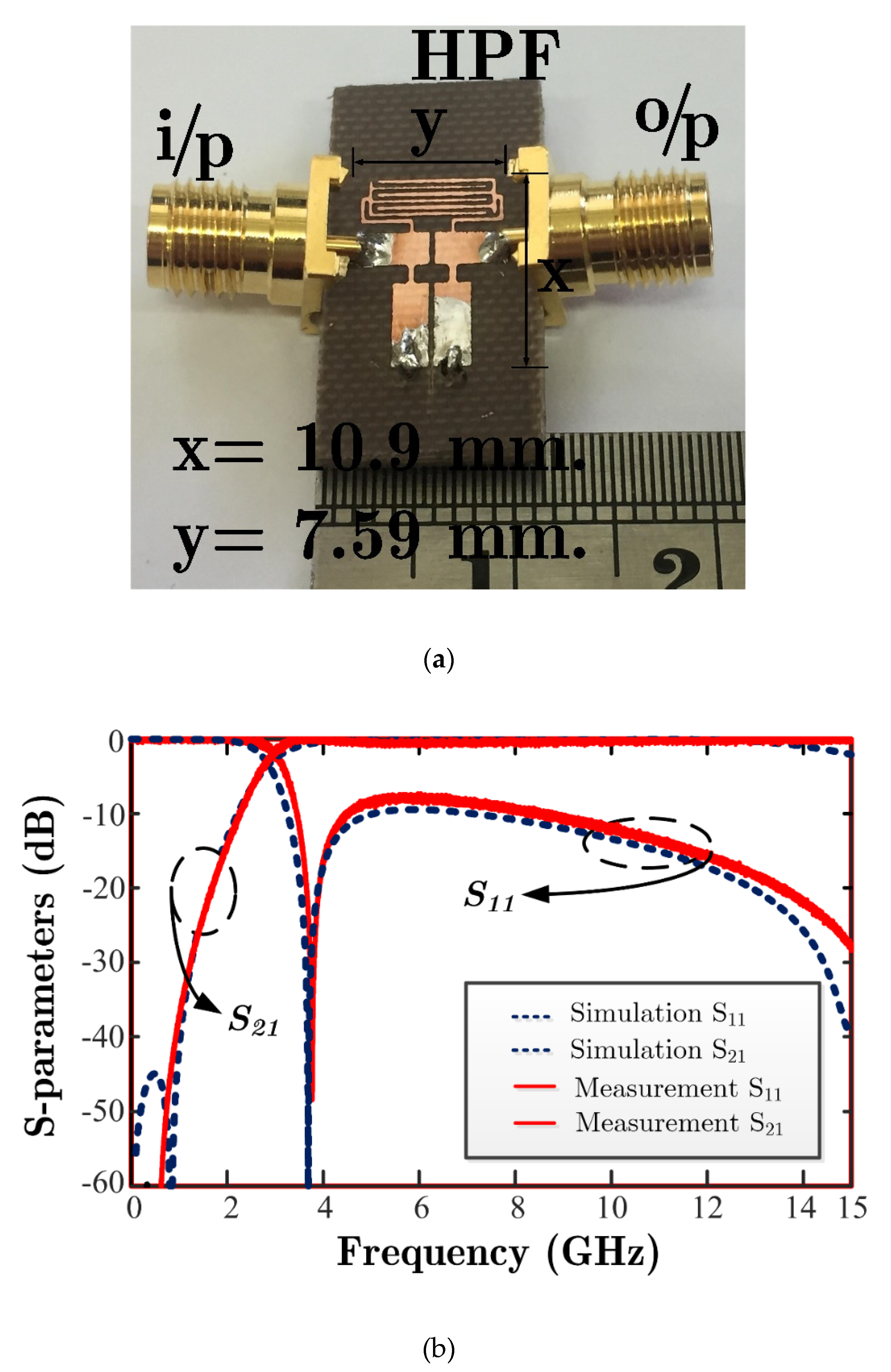Design of a Compact Ultra-Wideband Bandpass Filter Using Inductively Compensated Parallel-Coupled Lines
Abstract
1. Introduction
2. The Construction of the Proposed UWB-BPF
2.1. The ICPL
- where
- is characteristic impedance,
- is even-mode characteristic impedance,
- is odd-mode characteristic impedance,
- is even-mode effective dielectric constant,
- is odd-mode effective dielectric constant,
- is even-mode electrical length (),
- is odd-mode electrical length (),
- and .
2.2. Design of the HPF
2.3. Design of the LPF
2.4. Design of the Proposed UWB-BPF
3. Experimental Results and Discussions
4. Conclusions
Author Contributions
Funding
Data Availability Statement
Acknowledgments
Conflicts of Interest
References
- Sheng, H.; Orlik, P.; Haimovich, A.M.; Cimini, L.J.; Zhang, J. On the spectral and power requirements for ultra-wideband transmission. In Proceedings of the IEEE International Conference on Communications, Anchorage, AK, USA, 11–15 May 2003; pp. 738–742. [Google Scholar] [CrossRef]
- Meeloon, M.; Chaimool, S.; Akkaraekthalin, P. Broadband bandpass filters using slotted resonators fed by interdigital coupled lines for improving upper stopband performances. AEU-Int. J. Electron. Commun. 2009, 63, 454–463. [Google Scholar] [CrossRef]
- Sheleg, B.; Spielman, B.E. Broad-band directional couplers using microstrip with dielectric overlays. IEEE Trans. Microw. Theory Tech. 1974, 22, 1216–1220. [Google Scholar] [CrossRef]
- Hsu, C.; Hsu, F.; Kuo, J. Microstrip bandpass filters for ultra-wideband (UWB) wireless communications. In Proceedings of the IEEE MTT-S International Microwave Symposium Digest, Long Beach, CA, USA, 17 June 2005; pp. 679–682. [Google Scholar] [CrossRef]
- Cai, P.; Ma, Z.; Guan, X.; Yang, X.; Kobayashi, Y.; Anada, T.; Hagiwara, G. A compact UWB bandpass filter using two-section open-circuited stubs to realize transmission zeros. In Proceedings of the 2005 Asia-Pacific Microwave Conference Proceedings, Suzhou, China, 4–7 December 2005; pp. 1–4. [Google Scholar] [CrossRef]
- Yang, G.; Jin, R.; Geng, J.; Huang, X.; Xiao, G. Ultra-wideband bandpass filter with hybrid quasi-lumped elements and defected ground structure. IET Microw. Antennas Propag. 2007, 1, 733–736. [Google Scholar] [CrossRef]
- Longkul, A.; Angkawisittpan, A.; Suwannata, N. Design of a microstrip bandstop filter using folded spurline structures and its application. UBU Eng. J. 2012, 5, 48–55. Available online: https://ph02.tci-thaijo.org/index.php/eng_ubu/article/view/84348 (accessed on 20 September 2021).
- Bootthanu, N.; Angkawisittpan, N.; Chaimool, S. Development of wideband microstrip bandpass filters using DGS and stub. UTK Res. J. 2018, 12, 40–48. Available online: https://ph02.tci-thaijo.org/index.php/rmutk/article/view/142124 (accessed on 20 September 2021).
- Srisawat, S.; Angkawisittpan, N. A design of microstrip branch-line coupler with bandstop filter based on SITLs compensated parallel coupled lines. KKU Res. J. (GS) 2019, 19, 139–148. Available online: https://ph02.tci-thaijo.org/index.php/gskku/article/view/229439 (accessed on 20 September 2021).
- Aliqab, K.; Hong, J. Wideband differential-mode bandpass filters with stopband and common-mode suppression. IEEE Microw. Wirel. Compon. Lett. 2020, 30, 233–236. [Google Scholar] [CrossRef]
- Taibi, A.; Trabelsi, M.; Slimane, A.; Belaroussi, M.T.; Raskin, J. A novel design method for compact UWB bandpass filters. IEEE Microw. Wirel. Compon. Lett. 2015, 25, 4–6. [Google Scholar] [CrossRef]
- Wei, F.; Li, W.T.; Shi, X.W.; Huang, Q.L. Compact UWB bandpass filter with triple-notched bands using triple-mode stepped impedance resonator. IEEE Microw. Wirel. Compon. Lett. 2012, 22, 512–514. [Google Scholar] [CrossRef]
- Guvenli, K.; Yenikaya, S.; Secmen, M. Analysis, design, and actual fabrication of a hybrid microstrip-SIW bandpass filter based on cascaded hardware integration at X-band. Elektron. ir Elektrotechnika 2021, 27, 23–28. [Google Scholar] [CrossRef]
- Hong, J.; Lancaster, M.J. Microstrip Filters for RF/Microwave Applications; John Wiley & Sons: New York, NY, USA, 2001. [Google Scholar] [CrossRef]
- Gonzalez, G. Microwave Transistor Amplifiers: Analysis and Design; Pearson: London, UK, 1996; ISBN 0132543354. [Google Scholar]
- Chen, C. A coupled-line coupling structure for the design of quasi-elliptic bandpass filters. IEEE Trans. Microw. Theory Tech. 2018, 66, 1921–1925. [Google Scholar] [CrossRef]
- Phromloungsri, R.; Patisang, S.; Srisathit, K.; Chongcheawchamnan, M. A harmonic-suppression microwave bandpass filter based on an inductively compensated microstrip coupler. In Proceedings of the 2005 Asia-Pacific Microwave Conference Proceedings, Suzhou, China, 4–7 December 2005; pp. 1–4. [Google Scholar] [CrossRef]
- Kumpang, S.; Phromloungsri, R.; Chongcheawchamnan, M.; Krairiksh, M.; Robertson, I. Design and application of microstrip parallel-coupled lines employing step-impedance transmission-line compensation. IET Microw. Antennas Propag. 2009, 3, 410–415. [Google Scholar] [CrossRef]
- Phromloungsri, R.; Chongcheawchamnan, M.; Robertson, I. Inductively compensated parallel coupled microstrip lines and their applications. IEEE Trans. Microw. Theory Tech. 2006, 54, 3571–3582. [Google Scholar] [CrossRef]
- Sonasang, S.; Angkawisittpan, N. Design of microstrip parallel-coupled lines with high directivity using symmetric-centered inductors. Appl. Comput. Electromagn. Soc. J. 2021, 36, 657–663. [Google Scholar] [CrossRef]
- CST Studio Suite. Electromagnetic Field Simulation Software, Version 2021; Dassault Systèmes SE: Waltham, MA, USA, 2021. [Google Scholar]
- Phromloungsri, R.; Kumpang, S.; Chongcheawchamnan, M. Design high directivity parallel-coupled lines with step impedance transmission lines. In Proceedings of the 2008 Asia-Pacific Microwave Conference, Macau, China, 16–20 December 2008; pp. 1–4. [Google Scholar] [CrossRef]
- Thammawongsa, N.; Phromloungsri, R.; Jamsai, M.; Pornsuwancharoen, N. Design elliptic lowpass filter with inductively compensated parallel-coupled lines. Procedia Eng. 2012, 32, 550–555. [Google Scholar] [CrossRef][Green Version]
- Angkawisittpan, N.; Manasri, T. Determination of sugar content in sugar solutions using interdigital capacitor sensor. Meas. Sri. Rev. 2012, 12, 8–13. [Google Scholar] [CrossRef]
- Obma, J.; Sa-ngiamvibool, W. The non-substrate interdigital capacitor level sensor. Przegląd Elektrotechniczny 2020, 96, 34–37. [Google Scholar] [CrossRef]
- Shome, P.; Khan, T. A compact design of circular ring-shaped MMR based bandpass filter for UWB applications. In Proceedings of the 2019 IEEE Asia-Pacific Microwave Conference (APMC), Singapore, 10–13 December 2019; pp. 962–964. [Google Scholar] [CrossRef]
- Djeddi, T.; Elsaadany, M.; Shams, S.; Hamouda, W. Compact ultra-wideband printed bandpass filter based on coupled-line resonator loading. In Proceedings of the 2018 18th International Symposium on Antenna Technology and Applied Electromagnetics (ANTEM), Waterloo, ON, Canada, 19–22 August 2018; pp. 1–2. [Google Scholar] [CrossRef]
- Ye, J.; He, L.; Zhong, X.; Qu, D. Design of ultra-wideband bandpass (UWB) filter with enhanced couplings by using lumped capacitors. In Proceedings of the 2018 International Conference on Microwave and Millimeter Wave Technology (ICMMT), Chengdu, China, 7–11 May 2018; pp. 1–3. [Google Scholar] [CrossRef]










| Sections | Electrical Parameters | Components | Dimensions of PCL |
|---|---|---|---|
| HPF | |||
| LPF | |||
| Transmission Line | - |
| Sections | Electrical Parameters | Dimensions of PCLs | Components | |
|---|---|---|---|---|
| HPF | ||||
| LPF | ||||
| Transmission line | - |
| Reference | Passband (GHz) | Bandwidth (GHz) | Return Loss (dB) | Insertion Loss (dB) | Size (mm2) | Electrical Length Equation | Techniques |
|---|---|---|---|---|---|---|---|
| [26] | 3.05–10.62 | 7.57 (100.9%) | −13 | −1.5 | 122.40 | Available | Multiple mode resonator |
| [27] | 2.50–7.00 | 4.50 (60%) | −23 | No data | 9.94 | Not available | Coupled-line resonator |
| [28] | 3.00–10.20 | 7.20 (96%) | −14.9 | −2 | 263.25 | Not available | Lumped capacitors |
| This work | 2.92–10.95 | 8.03 (107%) | −12 | −0.49 | 121.48 | Available | ICPCL |
Publisher’s Note: MDPI stays neutral with regard to jurisdictional claims in published maps and institutional affiliations. |
© 2021 by the authors. Licensee MDPI, Basel, Switzerland. This article is an open access article distributed under the terms and conditions of the Creative Commons Attribution (CC BY) license (https://creativecommons.org/licenses/by/4.0/).
Share and Cite
Jamsai, M.; Angkawisittpan, N.; Nuan-On, A. Design of a Compact Ultra-Wideband Bandpass Filter Using Inductively Compensated Parallel-Coupled Lines. Electronics 2021, 10, 2575. https://doi.org/10.3390/electronics10212575
Jamsai M, Angkawisittpan N, Nuan-On A. Design of a Compact Ultra-Wideband Bandpass Filter Using Inductively Compensated Parallel-Coupled Lines. Electronics. 2021; 10(21):2575. https://doi.org/10.3390/electronics10212575
Chicago/Turabian StyleJamsai, Meechai, Niwat Angkawisittpan, and Adisorn Nuan-On. 2021. "Design of a Compact Ultra-Wideband Bandpass Filter Using Inductively Compensated Parallel-Coupled Lines" Electronics 10, no. 21: 2575. https://doi.org/10.3390/electronics10212575
APA StyleJamsai, M., Angkawisittpan, N., & Nuan-On, A. (2021). Design of a Compact Ultra-Wideband Bandpass Filter Using Inductively Compensated Parallel-Coupled Lines. Electronics, 10(21), 2575. https://doi.org/10.3390/electronics10212575






